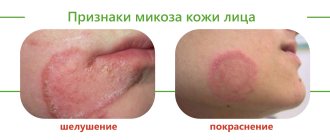Therapist
Berezhko
Olga Igorevna
Experience 36 years
General practitioner of the highest category, member of the Russian Scientific Medical Society of Therapists
Make an appointment
Vasculitis is a group of vascular diseases that are characterized by the development of an inflammatory process and subsequent necrosis of the vascular walls. The disease is also called arteritis or angiitis. As the disease progresses, a significant deterioration in blood circulation occurs. Pathology can affect arteries, veins, capillaries, venules and arterioles.
Types and classification of vasculitis
Vasculitis is divided into types:
- primary;
- secondary;
- systemic.
In the first case, we are talking about an independent and still just beginning disease. The second type may appear with other pathologies, for example, tumors. It can also occur as a reaction to an infection. Systemic vasculitis can occur in different ways. It leads to inflammation of blood vessels and damage to their walls, and tissue necrosis cannot be ruled out. Without proper treatment, complications usually occur, including death.
Based on the caliber of the affected vessels, a classification of vasculitis was identified. It may be in the form:
- arteritis (affects large vessels);
- phlebitis (affects the walls of the veins);
- arteriolitis (inflames the arteries and arterioles);
- capillaritis (affects capillaries).
Also included in a separate category is vasculopathy, which is characterized by the absence of clear signs of inflammation and infiltration of the vascular walls.
The degree of vascular damage can be mild, moderate and severe.
2. Why is vasculitis dangerous?
The danger of vasculitis lies in the possibility of developing serious complications. In particularly severe cases, when part of a blood vessel stretches and dilates, the likelihood of an aneurysm
– bulging section of the walls. The danger of this pathological process lies in the rupture of the aneurysm, which can cause many irreversible consequences: from circulatory disorders to death.
In the case of the opposite behavior of blood vessels during vasculitis, when inflammation contributes to their narrowing, there is a possibility of cessation of blood supply to individual organs and tissues. If alternative blood vessels cannot provide the required amount of blood to them, necrosis of the affected tissues or organs may occur.
Visit our Rheumatology page
Causes of the disease
The reasons for the formation of primary vasculitis are still unknown to science. Secondary disease can occur against the background of:
- acute or chronic infection;
- genetic (hereditary) predisposition;
- thermal effects (overheating or hypothermia of the body);
- various injuries;
- burns;
- contact with chemicals and poisons.
Another cause of vasculitis can be viral hepatitis. One or more risk factors are enough to change the antigenic structure of tissues. In this case, the immune system begins to secrete antibodies, which further damage the tissue, in this case the blood vessels. This leads to an autoimmune reaction and inflammatory and degenerative processes.
Causes of vasculitis
Doctors cannot yet fully determine the causes of primary vasculitis. There is an opinion that this disease is hereditary in nature and is associated with autoimmune disorders (autoimmune vasculitis), plus negative external factors and infection with Staphylococcus aureus play a role.
The cause of the development of secondary (infectious-allergic vasculitis) in adults is a previous infection.
Other causes of vasculitis include the following:
- allergic reaction (to medications, pollen, book dust, fluff);
- autoimmune diseases (systemic lupus erythematosus, thyroid diseases);
- vaccination;
- abuse of sunbathing;
- consequences of injuries;
- negative reaction of the body to various chemicals, poisons;
- hypothermia of the body;
1 Consultation with an ophthalmologist
2 Consultation with a neurologist
3 ENT consultation
Symptoms of vasculitis
Regardless of the type and form of the disease, the symptoms of vasculitis are similar. These include:
- decreased body temperature;
- joint pain;
- pale skin;
- regularly recurring sinusitis;
- vomiting;
- nausea;
- myalgia;
- rash in the form of spots, urticaria, subcutaneous nodules, hemorrhagic purpura, ulcers or blisters;
- sudden mood swings;
- convulsions;
- intoxication;
- drowsiness;
- sometimes pleurisy, bronchial asthma;
- loss of sensation (insemination);
- exacerbation of cardiovascular diseases;
- weakness;
- lack of appetite followed by weight loss.
Depending on the location, vasculitis can also manifest itself through a sharp deterioration in vision, inflammation and swelling of the eyes, pain in the lower back, in the kidney area, abdominal cramps and disruption of the gastrointestinal tract.
Are you experiencing symptoms of vasculitis?
Only a doctor can accurately diagnose the disease. Don't delay your consultation - call
3. Symptoms of the disease
The unpredictable nature of the occurrence of vasculitis makes its symptomatic picture very vague and diverse. And yet it is possible to identify the relationship between the signs of vasculitis and its location. For example, if skin damage occurs with vasculitis, then its symptom will be a specific rash. If there is a disruption in the blood supply to any part of the nerve, then a sign of this pathological process will be muscle weakness and loss of sensitivity. A stroke indicates a violation of the blood supply to the brain, and a heart attack indicates a violation of the blood supply to the heart.
Among the general symptoms of vasculitis, characteristic of all types of this disease, are the following:
- lack of appetite;
- weakness;
- increased body temperature;
- increased fatigue;
- pallor.
Therefore, it is very important to immediately consult a doctor if you notice any unclear symptoms of vasculitis.
About our clinic Chistye Prudy metro station Medintercom page!
Diagnostics
It is necessary to try to diagnose vasculitis even in the presence of the very first signs. The disease is serious and dangerous and requires immediate treatment.
If you suspect an illness, you must perform a series of examinations and tests. Appointed:
- angiography;
- general blood and urine tests;
- ECHO-cardiography;
- blood biochemistry;
- Ultrasound of the heart, abdominal organs and kidneys;
- X-rays of light.
The problem is that it is very difficult to diagnose vasculitis in the early stages. But more striking signs of the disease and a reason to sound the alarm appear even when several organs are affected at once.
In severe and rapid progression of the disease, an additional biopsy is performed, followed by a detailed study of tissue samples.
Diagnosis of vasculitis on the legs
Previously, we covered the topic of diagnosing eczema on the legs. You will find a photo of eczema on the legs at the initial stage here. Now let's move on to the diagnosis of vasculitis.
The basis for diagnosing vasculitis includes the following studies:
- Complete blood count : presence of anemia, increased erythrocyte sedimentation rate and leukocytosis;
- General urine analysis : the presence of protein (proteinuria), cylindruria and in some cases even blood in the urine;
- Biochemical blood test: with vasculitis, it will show a violation of the ratios of certain protein fractions (dysproteinemia)
- Musculocutaneous flap biopsy , which is the main procedure to confirm the disease. With vasculitis, this biopsy will contain significant inflammatory and necrotic lesions of small vessels.
Treatment of vasculitis
Treatment of vasculitis is prescribed depending on the type of organs affected and concomitant diseases. If the primary form of the disease appears against the background of an allergy, it usually disappears on its own and does not require additional measures.
If the source of the disease affects vital organs, such as the heart, brain, kidneys or lungs, then the patient is prescribed a course of intensive therapy.
To stabilize blood circulation, treatment can be carried out both at home and in a hospital setting. Pregnant women, children and patients with severe forms of the disease are required to be hospitalized.
Use:
- chemotherapy;
- corticosteroids;
- NSAIDs;
- anticoagulants;
- enterosorbents;
- antiplatelet agents;
- antihistamines;
- cytostatics.
Additionally, plasmapheresis, hemosorption and immunosorption are included.
Prevention
At the moment, there are no means of prevention that would completely prevent the development of vasculitis. However, using certain preventive methods, it is possible to reduce the effect on the body of factors that provoke the development of vasculitis.
These include:
- Thorough check of the quality of administered vaccines;
- Timely treatment of infectious diseases;
- Dosage of time spent in the sun (hyperinsolation is one of the factors that increases the risk of developing vasculitis);
- Lifestyle modification: adequate exercise and nutrition.
FAQ
What is the prognosis for vasculitis?
With timely consultation with a doctor, patient survival is 90%.
Is it possible to treat vasculitis at home?
If the patient’s condition and the identified stage of disease development allows this, then it is possible. Only the most difficult cases are hospitalized. Others can take medications on their own.
If you suspect vasculitis, who should you turn to for help?
First of all, you should make an appointment with a therapist, who, after collecting an anamnesis, will refer the patient to specialized specialists: a vascular surgeon, cardiologist, hematologist, etc.
Complications
Since the vascular network interweaves all organ systems, performing trophic (nutritional) and respiratory functions for them, vascular necrosis has an extremely negative effect on the organs themselves: due to malnutrition, their ischemia develops, which leads to a decrease in the function of one or another structure.
The following main consequences of vasculitis are usually identified:
- Kidney damage and the formation of chronic renal failure, up to the development of anuria;
- Ischemic heart damage, development or worsening of coronary heart disease, development of aneurysms and valve defects;
- Lesions of the gastrointestinal tract: necrosis and intussusception, the formation of intestinal obstruction;
- Risk of developing hemorrhagic stroke.
The most common forms of pathology:
- Hemorrhagic vasculitis (according to clinical forms, it is divided into cutaneous, abdominal, renal and articular vasculitis). It occurs mainly in childhood and affects mainly small vessels. The main symptoms are a palpable rash (purpura), gastrointestinal and kidney dysfunction, and joint pain.
- Cutaneous vasculitis. It develops exclusively in small and medium-sized vessels of the subcutaneous tissue. It manifests itself as a rash, purpura or ulcers.
- Behçet's disease (Adamantiadis-Behçet). Affects the mucous membranes of the eyes, mouth, genitals and skin. As the disease progresses, ulcers appear on the mucous membranes. In addition, the disease affects the gastrointestinal tract and brain.
Hemorrhagic vasculitis
Clinical picture:
The disease often begins in the spring, and in many patients it begins after an upper respiratory tract infection. The main clinical sign of the disease is a profuse hemorrhagic rash with a diameter, usually 3-10 mm, localized mainly on the legs (especially the legs and feet) and buttocks. In many patients, it protrudes slightly above the skin, i.e., it is papular-hemorrhagic in nature, and is occasionally accompanied by mild itching, as well as slight swelling of the feet, legs, or periorbital swelling. Often the appearance of a rash is preceded by a feeling of tingling or slight itching in the places where it will be localized. A hemorrhagic rash on the upper half of the torso and arms occurs much less frequently and is less pronounced, but is quite possible. Lesions on the skin of the neck and face are completely atypical. Hemorrhages on the legs can be very abundant and often merge. In the absence of new rashes, they begin to fade within 2-3 days and subsequently disappear without a trace. The rash usually appears suddenly; subsequently (especially after prolonged standing or walking), new “waves” of rashes often follow, which may be accompanied by a moderate increase in temperature, a slight increase in ESR and neutrophilic leukocytosis. The platelet count is normal.
In many patients, the clinical signs of the disease are limited to skin manifestations. However, other syndromes, especially articular ones, often come to the fore. It manifests itself as a reversible, non-migratory arthritis, usually affecting more than one joint. The most typical involvement in the process is the joints of the legs - ankle and knee; The participation of the wrist and elbow is less common. A number of patients have only arthralgia. Synovial fluid from affected joints is distinctly inflammatory in nature with high neutrophilic leukocytosis. Arthritis always ends with complete recovery without any elements of destruction. Renal involvement occurs in a few patients and is usually mild and transient. It is manifested by hematuria and slight proteinuria. Much less commonly, kidney damage progresses and leads to kidney failure, which can cause death. Histologically, focal glomerulitis is detected with endothelial proliferation and fibrinoid deposits. In some patients, the vessels of the digestive tract are affected, which manifests itself as abdominal pain, sometimes colicky. Its causes are usually hemorrhages and swelling of the intestinal wall or mesentery. In rare cases, diarrhea with protein loss or intestinal bleeding may occur; volvulus and perforation have been described. It is significant that in a number of patients with hemorrhagic vasculitis, abdominal pain is the first sign of the disease, causing serious diagnostic difficulties and sometimes leading to unnecessary surgical interventions. The literature also contains isolated descriptions of hemorrhages in the eye tissue and in the central nervous system with severe headache, hypertensive encephalopathy and convulsions.
In most cases, the disease is not severe and ends in recovery, although it often recurs. The prognosis becomes serious with the evolution of renal changes into chronic glomerulonephritis and with such very rare manifestations as intestinal bleeding, volvulus or perforation of the intestine and cerebral hemorrhage.
Treatment
A patient with vasculitis may be prescribed:
- glucocorticosteroids;
- non-steroidal anti-inflammatory drugs;
- cytostatics;
- plasmapheresis;
- hemosorption;
- antibiotics.
Treatment is carried out in three stages:
- A short course of aggressive therapy.
- Long-term use of immunosuppressants to maintain remission (up to two years).
- Relapse therapy.
Metypred is used for basic therapy of vasculitis
Treatment is carried out by rheumatologists, but doctors of other specialties may be involved: hematologists, dermatologists, nephrologists, neurologists, cardiologists and others.
For leg vasculitis, proper nutrition is recommended. You should avoid spicy, salty, chocolate, canned foods, citrus fruits, strong tea and coffee.
Drugs
The main treatment for vasculitis is therapy with glucocorticosteroids, which can achieve long-term remission. The most commonly used drugs are prednisolone (Metypred).
Combined treatment - glucocorticosteroids and cytostatics (cyclophosphamide) - is indicated for severe forms of vasculitis. Therapy lasts from three months to a year. Cyclophosphamide is injected into a vein in ultra-high doses. It is more effective than oral administration because it helps reduce the dose while maintaining the therapeutic effect and reduces the incidence of side effects.
Non-steroidal anti-inflammatory drugs include Indomethacin and Ibuprofen.
Other drugs may be required, including: antiviral and antimicrobial, anticoagulants, antiplatelet agents, ACE inhibitors, vasodilators.
For glomerulonephritis, intravenous immunoglobulin may be indicated.
For severe kidney damage, plasmapheresis may be prescribed in some cases. It is believed to help improve prognosis regarding kidney function.
Drugs that strengthen blood vessels, reduce their permeability and fragility (rutin, vitamin C), dilate blood vessels and improve microcirculation (Pentoxifylline), and drugs that prevent the formation of blood clots (acetylsalicylic acid) are used.
For faster healing of rash elements on the legs, local remedies are used
For skin manifestations on the legs, local medications are prescribed:
- antiseptics (diamond green, Ethacridine);
- as an anti-inflammatory agent - applications with Dimexide;
- to speed up the process of tissue restoration - Solcoseryl;
- when ulcers form in areas of affected vessels - Iruksol.
Overdiagnosis of systemic vasculitis
Inflammation of the wall of blood vessels is an integral symptom of vasculitis, which is found in all patients without exception.
However, there are also other types of errors associated with overdiagnosis of primary vasculitis. Among clinicians with little practical knowledge of vasculitis, there is a tendency to call “systemic vasculitis” (especially often “polyarteritis nodosa” and “hemorrhagic vasculitis”) any unclear condition when the patient has a prolonged fever and has one or another set of nonspecific symptoms. Very often in such situations, the diagnosis seems to be proven by a skin biopsy - an examination of an excised area of skin and subcutaneous tissue under a microscope, revealing vascular inflammation. However, this research method does not reliably distinguish between primary systemic vasculitis and secondary (symptomatic) vasculitis.
How to prevent exacerbations?
After discharge from the hospital, the patient should not forget about his illness at home. Of course, by that time he will already know everything about the nature of the disease, prevention of exacerbations, behavior in everyday life, nutrition and daily routine. Having immersed himself in a homely atmosphere, the patient will not take any medications without a doctor’s prescription, will not attack foods that can provoke a relapse (allergens), but will eat well and will take quiet, easy walks in the fresh air every evening.
In addition, the following are contraindicated for a person:
- Excessive anxiety, mental stress;
- Vaccinations (possible only for health reasons);
- Hard physical labor (children are exempt from physical education lessons);
- Hypothermia;
- Administration of immunoglobulins (antistaphylococcal, antitetanus, etc.).
Due to the fact that hemorrhagic vasculitis is predominantly a childhood disease, special recommendations are provided for children (or parents?):
- Every six months the child visits the attending physician (in the absence of exacerbations);
- Clinical observation for at least 5 years if the kidneys remain healthy, but if they are damaged, control may be lifelong;
- Children are completely exempt from physical education for a year, then move to the preparatory group;
- A mandatory visit to the dentist and otolaryngologist is required 3 times a year;
- Regular urine tests (general and Nechiporenko) and fecal tests for helminths;
- Vaccinations are excluded for 2 years, and after this time, routine vaccination is carried out, but with the permission of the attending physician and under “antihistamine cover”;
- Compliance with an anti-allergenic diet – 2 years;
Advice to parents or other relatives about treatment at home, relapse prevention, nutrition and behavior at school and at home.
Main primary vasculitis:
- Takayasu arteritis (synonyms: “nonspecific aortoarteritis”,
- "aortic arch syndrome")
- giant cell arteritis (synonyms: “temporal arteritis”,
- "senile arteritis", "Horton's disease")
- polyarteritis nodosa
- Kawasaki disease
- granulomatosis with polyangiitis (synonym: “Wegener’s granulomatosis”)
- microscopic polyangiitis
- eosinophilic granulomatosis with polyangiitis (synonym: “Churg-Strauss syndrome”)
- cryoglobulinemic vasculitis
- IgA vasculitis (synonyms: “hemorrhagic vasculitis”, “Henoch-Schönlein purpura”)
- Hypocomplementary urticarial vasculitis (synonym: “anti-C1q-associated vasculitis”)
- Anti-BMK-associated disease (synonym: “Goodpasture syndrome”)
Primary vasculitis is an independent disease that falls primarily within the competence of rheumatologists, although the diagnosis and treatment of these diseases is impossible without the participation of doctors of other specialties: otolaryngologists, ophthalmologists, neurologists, dermatologists, etc.
The caliber of affected blood vessels in different forms of vasculitis is not the same and varies from large arteries (with a diameter of 1.0 cm or more) to the smallest arterioles, capillaries and venules, visible only under a microscope. The type of inflammation is also different. All this explains the extremely pronounced diversity of clinical manifestations of primary systemic vasculitis and their dissimilarity from each other.









